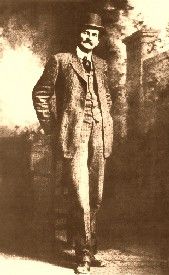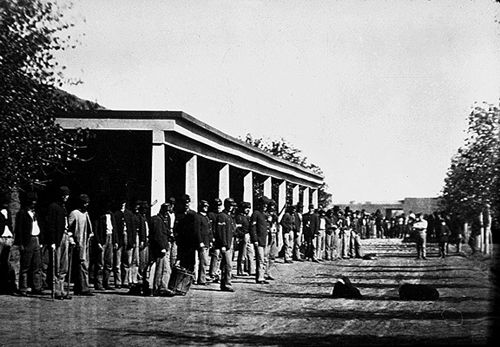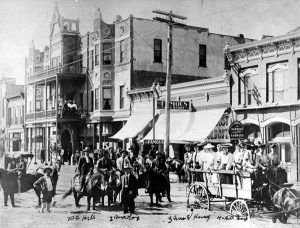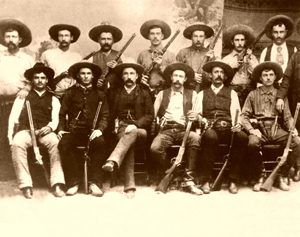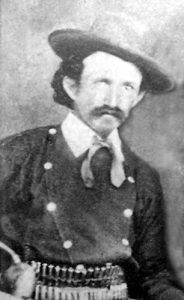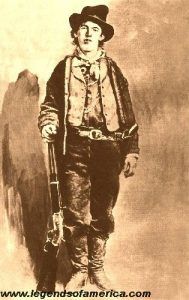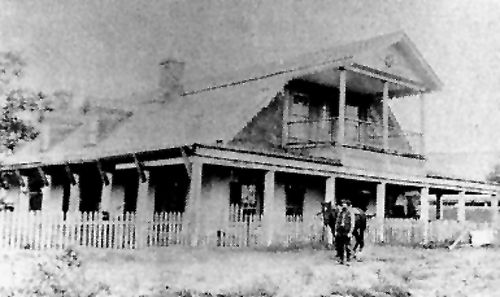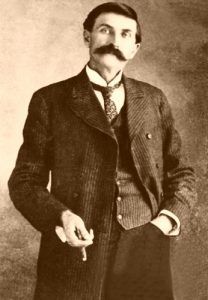By Emerson Hough in 1905
The deeds of the Western sheriff often went un-chronicled or were luridly set forth in fiction as incidents of blood, interesting only because of their bloodiness. The frontier officer himself, usually not a man to boast of his own acts, quietly stepped into the background of the past and was replaced by others who more loudly proclaimed their prominence in the advancement of civilization. Yet, the typical frontier sheriff, the good man who went after bad men and made it safe for men to live and own property and to establish homes and to build up a society and a country and a government, is a historical character of great interest. Among very many good ones, we shall perhaps best get at the type of all by giving the story of one, and we shall also learn something of the dangerous business of man hunting in a region filled with men who must be hunted down.
Patrick Floyd Garrett, better known as Pat Garrett, was a Southerner by birth. He was born in Chambers County, Alabama, on June 5, 1850. In 1856, his parents moved to Claiborne Parish, Louisiana, where his father was a large landowner and, of course, at that time and place, a slave owner and among the bitter opponents of the new regime that followed the Civil War.
When young Garrett’s father died, the large estates dwindled under bad management. When, within a short time, his mother followed her husband to the grave, the family resources affected by the war became involved. However, the two Garrett plantations embraced nearly three thousand acres of rich Louisiana soil. On January 25, 1869, Pat Garrett, a tall and slender youth of eighteen, set out to seek his fortunes in the wild West, with no resources but such as lay in his brains and body.
He went to Lancaster in Dallas County, Texas. A big ranch owner in southern Texas wanted men, and Pat Garrett packed up and went home with him. The world was new to him, however, and he went off with the northbound cows, like many other youngsters of the time. His herd was made up at Eagle Lake, and he only accompanied the drive as far north as Denison. There, he began to get uneasy, hearing of the delights of the still wilder life of the buffalo hunters on the great plains that lay to the northwest in the Panhandle of Texas. For three winters, 1875 to 1877, he was in and out between the buffalo range and the settlements, by this time well wedded to frontier life.
In the fall of 1877, he went West once more, and this time, he kept on going west. With two hardy companions, he pushed on entirely across the wild and unknown Panhandle country, leaving the wagons near what was known as the “Yellow Houses” and never returning to them. His blankets, personal belongings, etc., he never saw again. He and his friends had their heavy Sharps’ rifles, plenty of powder and lead, and their reloading tools, and they had nothing else. Their beds they made of their saddle blankets and the food they killed from the wild herds. For their love of adventure, they rode on across an unknown country until finally, they arrived at the little Mexican settlement of Fort Sumner, New Mexico, on the Pecos River, in the month of February 1878.
Pat and his friends were hungry, but all the cash they could find was just one dollar and a half between them. They gave it to Pat and sent him over to the store to see about eating. He asked the price of meals, and they told him fifty cents per meal. They would permit them to eat but once. He decided to buy a dollar and a half’s worth of flour and bacon, which would last for two or three meals. He joined his friends, and they went to camp on the river bank, where they cooked and ate, perfectly happy and quite careless about the future.
As they finished their breakfast, they saw up the river the dust of a cattle herd and noted that a party was working a herd, cutting out cattle for some purpose or other.
“Go up there and get a job,” said Pat to one of the boys. The latter did go up but came back reporting that the boss did not want any help.
“Well, he’s got to have help,” said Pat. So saying, he arose and started upstream himself.
Garrett was at that time, as has been said, of very great height, six feet four and one-half inches, and very slender. Unable to get trousers long enough for his legs, he had pieced down his best pair with about three feet of buffalo leggings with the hair out. Gaunt, dusty, and unshaven, he looked hard, and when he approached the herd owner and asked for work, the other was as much alarmed as pleased. He declined again, but Pat firmly told him he had come to go to work and was sorry, but it could not be helped. Something in the quiet voice of Garrett seemed to arrest the attention of the cowman. “What can you do, Lengthy?” he asked.
“Ride anything with hair, and rope better than any man you’ve got here,” answered Garrett, casting a critical glance at the other men.
The cowman hesitated a moment and then said, “Get in.” Pat got in. He stayed in. Two years later, he was still at Fort Sumner and married.
Garrett moved down from Fort Sumner soon after his marriage and settled a mile east of what is now the flourishing city of Roswell, New Mexico, at a spring on the bank of the Hondo River and in the middle of what was then the virgin plains. Here, he picked up land until he had more than 1,250 acres.
He was not, however, to live the steady life of the frontier farmer. His friend, Captain J. C. Lea of Roswell, came to him and asked if he would run as sheriff of Lincoln County. Garrett consented and was elected. He was warned not to take this office, and word was sent to him by the bands of hard-riding outlaws of that region that if he attempted to serve any processes on them, he would be killed. He paid no attention to this, and, as he was still an unknown quantity in the country, which was new and thinly settled, he seemed sure to be killed. He won the absolute confidence of the governor, who “told him to go ahead, not to stand on technicalities, but to break up the gang that had been rendering life and property unsafe for years and making the territory a mockery of civilization. If the truth were known, it might perhaps be found that sometimes Garrett arrested a bad man and got his warrant for it later when he went to the settlements. He found a straight six-shooter the best sort of warrant, and in effect, he took the matter of establishing a government in southwestern New Mexico into his own hands and did it in his own way. He was the whole machinery of the law. Sometimes, he boarded his prisoners out of his own pocket. He himself was the state, and his word was good, even to the worst cutthroat that ever he captured. Often, he had in his care prisoners whom, under the law, he could not legally have held, had they been demanded of him; but, he held them in spite of any demand, and the worst prisoner on that border knew that he was safe in Pat Garrett’s hands, no matter what happened, and that if Pat said he would take him through to any given point, he would take him through.
After he had finished his first season of work as a sheriff and as U.S. Deputy Marshal, Garrett ranched for a time. In 1884, his reputation as a criminal-taker being now a wide one, he organized and took charge of a company of Texas Rangers in Wheeler County, Texas, and made Atascosa and thereabouts his headquarters for a year and a half. So great became his fame as a man-taker that he was employed to manage the affairs of a cattle detective agency, it being now so far along in civilization that men were beginning to be careful about their cows. He was offered ten thousand dollars to break up a certain band of raiders working in upper Texas, and he did it. However, he found that he was really being paid to kill one or two men and not to capture them and, being unwilling to act as the agent of any man’s revenge, he quit this work and went into the employment of the “V” ranch in the White Mountains.
He then moved down to Roswell again in the spring of 1887. Here, he organized the Pecos Valley Irrigation Company. He was the first man to suspect the presence of artesian water in this country, where the great Spring rivers push up from the ground, and through his efforts, wells were bored, which revolutionized all that valley. He ran for sheriff of Chaves County and was defeated. Angry at his first reverse in politics, he pulled up at Roswell and sacrificed his land for what he could get for it. By the early 1900s, it was covered with crops and fruits and worth sixty to one hundred dollars an acre.
Garrett then went back to Texas and settled near Uvalde, where he engaged once more in an irrigation enterprise. He was there for five years, ranching and losing money. W. T. Thornton, the governor of New Mexico, sent for him and asked him if he would take the office of sheriff of Donna Ana County to fill the unexpired term of Numa Raymond. He was elected to serve two subsequent terms as sheriff of Donna Ana County, and no frontier officer had a better record for bravery.
In the month of December 1901, President Theodore Roosevelt, who had heard of Garrett, met him and liked him, and without any ado or consultation, appointed him collector of customs at El Paso, Texas. Here, for the next four years, Garrett became a popular collector and an honest and fearless one.
The main reputation gained by Garrett was through his killing the desperado, Billy the Kid. It is proper to set down here the chronicle of that undertaking because that will best serve to show the manner in which a frontier sheriff gets a bad man.
When the Kid and his gang killed the agency clerk, Bernstein, on the Mescalero Reservation, they committed murder on United States Government grounds — an offense against United States law. A United States warrant was placed in the hands of Pat Garrett, then a U.S. Deputy Marshal and sheriff-elect, and he took up the trail, locating the men near Fort Sumner, at the ranch of one Wayne Brazel, about nine miles east of the settlement. With the Kid were Charlie Bowdre, Tom O’Folliard, Tom Pickett, and Dave Rudabaugh, fellows of like kind. Rudabaugh had just broken jail in Las Vegas and had killed his jailer. Not a man of the band had ever hesitated at murder. They were now eager to kill Garrett and kept watch, as best they could, on all his movements.
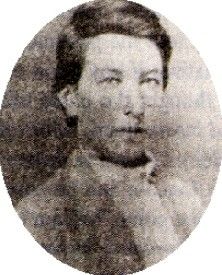
Tom “Big Foot” O’Folliard
One day, Garrett and some of his improvised posse were riding eastward of the town when they jumped Tom O’Folliard, who was mounted on a horse that proved too good for them in a chase of several miles. Garrett, at last, was left alone following O’Folliard and fired at him twice. The latter later admitted that he fired twenty times at Garrett with his Winchester, but it was hard to do good shooting from the saddle at two or three hundred yards range, so neither man was hit. O’Folliard did not learn his lesson. A few nights later, in company with Tom Pickett, he rode into town.
Warned of his approach, Garrett, with another man, was waiting, hidden in the shadow of a building. As O’Folliard rode up, he was ordered to throw up his hands but went after his gun instead, and in the instant, Garrett shot him through the body. “You never heard a man scream the way he did,” said Garrett. “He dropped his gun when he was hit, but we did not know that, and as we ran up to catch his horse, we ordered him again to throw up his hands. He said he couldn’t, that he was killed. We helped him down then and took him into the house. He died about forty-five minutes later. He said it was all his own fault and that he didn’t blame anybody. I’d have killed Tom Pickett right there, too,” concluded Garrett, “but one of my men shot right past my face and blinded me for the moment, so Pickett got away.”
The remainder of the Kid’s gang was now located in the stone house mentioned above, and their whereabouts were reported by the ranchman whose house they had just vacated. The manhunt, therefore, proceeded methodically, and Garrett and his men, of whom he had only two or three upon whom he relied as thoroughly game, surrounded the house just before dawn. Garrett, with Jim East and Tom Emory, crept up to the head of the ravine, which made up to the ridge on which the fortress of the outlaws stood. The early morning is always the best time for a surprise of this sort. It was Charlie Bowdre who first came out in the morning, and as he stepped out of the door, his career as a bad man ended. Three bullets passed through his body. He stepped back into the house but only lived about 20 minutes. The Kid said to him, “Charlie, you’re killed anyhow. Take your gun and go out and kill that long-legged before you die.” He pulled Bowdre’s pistol around in front of him and pushed him out of the door. Bowdre staggered feebly toward the spot where the sheriff was lying. “I wish—I wish,” he began and motioned toward the house, but he could not tell what it was that he wished. He died on Garrett’s blankets, which were laid down on the snow.
Previous to this, Garrett had killed one horse at the door beam where it was tied and, with a remarkable shot, had cut the other free, shooting off the rope that held it. These two shots he thought about the best he ever made, and this is saying much, for he was a phenomenal shot with rifle or revolver. There were two horses inside, but the dead horse blocked the door. Pickett now told the gang to surrender. “That fellow will kill every man that shows outside that door,” said he, “that’s all about it. He’s killed O’Folliard, and he’s killed Charlie, and he’ll kill us. Let’s surrender and take a chance at getting out again.” They listened to this, for the shooting they had seen had pretty well broken their hearts.
Garrett then went over to the ranch house for food for his men, and the cooking was too much for the hungry outlaws, who had had nothing to eat. They put up a dirty white rag on a gun barrel and offered to give up. One by one, they came out and were disarmed. That night was spent at the Brazel ranch, the prisoners under guard and the body of Charlie Bowdre, rolled in its blankets, outside in the wagon. The next morning, Bowdre was buried in the little cemetery next to Tom O’Folliard. The Kid did not know that he was to make the next in the row.
These men surrendered on condition that they should all be taken through to Santa Fe, and Garrett, at the risk of his life, took them through Las Vegas, where Rudabaugh was wanted. Half the town surrounded the train in the depot yards. Garrett told the Kid that if the mob rushed in the door of the car, he would toss back a six-shooter to him and ask him to help fight.
“All right, Pat,” said the Kid cheerfully. “You and I can whip the whole gang of them, and after we’ve done it, I’ll go back to my seat, and you can put the irons on again. You’ve kept your word.” There is little doubt that he would have done this, but, as it chanced, there was no need since at the last moment, Deputy Malloy of Las Vegas jumped on the engine and pulled the train out of the yard.
Billy the Kid was tried and condemned to be executed. He had been promised a pardon by Governor Lew Wallace, but the pardon did not come. A few days before the day set for his execution, the Kid, as elsewhere described, killed the two deputies who were guarding him and got back once more to his old stomping grounds around Fort Sumner.
“I knew now that I would have to kill the Kid,” said Garrett to the writer, speaking reminiscently of the bloody scenes as we lately visited that country together. “We both knew that it must be one or the other of us if we ever met. I followed him up here to Sumner, as you know, with two deputies, John Poe and ‘Tip’ McKinney, and I killed him in a room up there at the edge of the old Cottonwood Avenue.”
He spoke of events now long gone by. It had been only with difficulty that we located the site of the building where the Kid’s gang had been taken prisoners. The structure itself had been torn down and removed. As to the old military post, once a famous one, it offered now nothing better than a scene of desolation. There was no longer a single human inhabitant there. The old avenue of cottonwoods, once four miles long, was now ragged and unwatered, and the great parade ground had gone back to sand and sagebrush. We were obliged to search for some time before we could find the site of the old Maxwell house, in which was ended a long and dangerous manhunt of the frontier. Garrett finally located the place, now only a rough quadrangle of crumbled earthen walls.
“This is the place,” said he, pointing to one corner of the grass-grown oblong. “Pete Maxwell’s bed was right in this corner of the room, and I was sitting in the dark and talking to Pete, who was in bed. The Kid passed Poe and McKinney right over there, on what was then the gallery, and came through the door right here.”
We paused for a time and looked with a certain gravity at this wind-swept, desolate spot, around which lay the wide, unwinking desert. About us were the ruins of what had been a notable settlement in its day but which now had passed with the old frontier.
“I got word of the Kid up here in much the way I had once before,” resumed Garrett at length, “and I followed him, resolved to get him or to have him get me. We rode over to the edge of the town and learned that the Kid was there, but of course, we did not know which house he was in. Poe went in to inquire around, as he was not known there like myself. He did not know the Kid when he saw him, nor did the Kid know him.
“It was a glorious moonlight night; I can remember it perfectly well. Poe, McKinney, and I all met a little way out from the edge of the place. We decided that the Kid was not far away. We went down to the houses, and I put Poe and McKinney outside of Pete Maxwell’s house, and I went inside. Right here was the door. We did not know it at that time, but just about then, the Kid was lying with his boots off in the house of an old Mexican just across there, not very far away from Maxwell’s door. He told the Mexican, when he came in, to cook something for him to eat. Maxwell had killed a beef not long before, and there was a quarter hanging up under the porch out in front. After a while, the Kid got up, got a butcher knife from the old Mexican, and concluded to go over and cut himself off a piece of meat from the quarter at Maxwell’s house. This is how the story arose: he came into the house with his boots in his hand to keep an appointment with a Mexican girl.
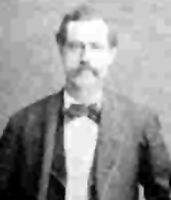
Peter Maxwell
“The usual story is that I was down close to the wall behind Maxwell’s bed. This was not the case, for the bed was close to the wall. Pete Maxwell was lying in bed, right here in this corner, as I said. I was sitting in a chair and leaning over toward him as I talked in a low tone. My right side was toward him, and my revolver was on that side. I did not know that the Kid was so close at hand or, indeed, know for sure that he was there in the settlement at all.
“Maxwell did not want to talk very much. He knew the Kid was there and knew his own danger. I was talking to him in Spanish, in a low tone of voice, as I say, when the Kid came over here, just as I have told you. He saw Poe and McKinney sitting right out there in the moonlight but did not suspect anything. ‘¿Quien es?’—’ Who is it?’—he asked as he passed them. I heard him speak and saw him come back into the room, facing toward Poe and McKinney. He could not see me, as it was dark in the room, but he came up to the bed where Maxwell was lying and where I was sitting. He seemed to think something might not be quite right. He had in his hand his revolver, a self-cocking .41. He could not see my face, and he had not heard my voice, or he would have known me.
“The Kid stepped up to the bedside and laid his left hand on the bed, and bent over Maxwell. He saw me sitting there in the half-darkness but did not recognize me as I was sitting down. My height would have betrayed me had I been standing. ‘Pete, ¿Quien es?’ he asked in a low tone of voice, and he half motioned toward me with his six-shooter. That was when I looked across into eternity. It wasn’t far to go.
“That was exactly how the thing was. I gave neither Maxwell nor the Kid time for anything further. There flashed over my mind at once one thought, and it was that I had to shoot and shoot at once and that my shot must go to the mark the first time. I knew the Kid would kill me in a flash if I did not kill him.
“Just as he spoke and motioned toward me, I dropped over to the left and rather down, going after my gun with my right hand as I did so. As I fired, the Kid dropped back. I had caught him just about the heart. His pistol, already pointed toward me, went off as he fell, but he fired high. As I sprang up, I fired once more but did not hit him and did not need to, for he was dead.
“I don’t know that he ever knew who It was that killed him. He could not see me in the darkness. He may have seen me stoop over and pull. If he had had the least suspicion of who it was, he would have shot as soon as he saw me. When he came to the bed, I knew who he was. The rest happened, as I have told you. There is no other story about the killing of Billy the Kid, which is the truth. It is also untrue that his body was ever removed from Fort Sumner. It lies there today, and I’ll show you where we buried him. I laid him out myself in this house here, and I ought to know.”
Twenty-five years of time had done their work in all that country, as we learned when we entered the little barbed-wire enclosure of the cemetery where the Kid and his fellows were buried. There are no headstones in this cemetery, and no sacristan holds its records. Again, Garrett had to search in the saltgrass and greasewood. “Here is the place,” said he at length. “We buried them all in a row. The first grave is the Kid’s, and next to him is Bowdre, and then O’Folliard.”
Here was the sole remaining record of the manhunt’s end. So passes the glory of the world! In this desolate resting place, in a wind-swept and forgotten graveyard, rests all the remaining fame of certain bad men who, in their time, were bandit kings who ruled by terror over half a Western territory. Even the headboard which once stood at the Kid’s grave—and which was once riddled with bullets by cowards who would not have dared to shoot that close to him had he been alive—was gone. It is not likely that the graves will be visited again by anyone who knows their locality. Garrett looked at them in silence for a time, then, turning, went to the buckboard for a drink at the canteen. “Well,” said he quietly, “here’s to the boys, anyway. If there is any other life, I hope they’ll make better use of it than they did of the one I put them out of.”
Emerson Hough, 1907 – Compiled and edited by Kathy Alexander/Legends of America, updated October 2023.
Go To the Next Chapter – Bad Men Of Texas
About the Author: Excerpted from the book The Story of the Outlaw; A Study of the Western Desperado, by Emerson Hough; Outing Publishing Company, New York, 1907. This story is not verbatim, as it has been edited for clerical errors and updated for the modern reader. Emerson Hough (1857–1923).was an author and journalist who wrote factional accounts and historical novels of life in the American West. His works helped establish the Western as a popular genre in literature and motion pictures. For years, Hough wrote the feature “Out-of-Doors” for the Saturday Evening Post and contributed to other major magazines.
Also See:
Pat Garrett – An Unlucky Lawman
Billy The Kid – Teenage Outlaw of New Mexico
Billy the Kid – Fatal Shot in the Dark (by Pat Garrett, 1882)
Other Works by Emerson Hough:
The Story of the Outlaw – A Study of the Western Desperado – Entire Text
Cowboys on the American Frontier
The Range of the American West

